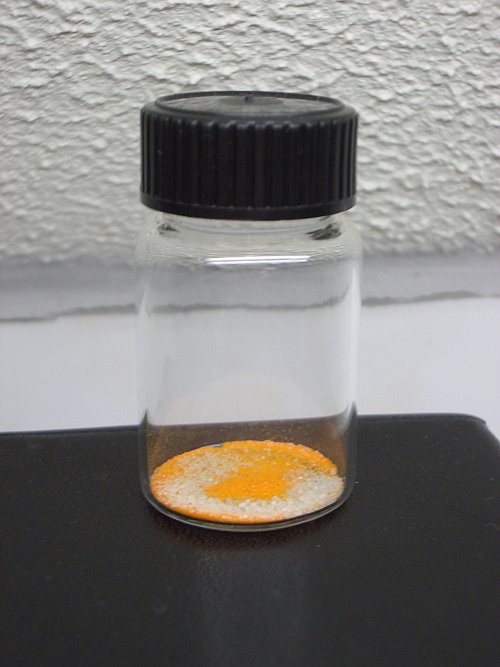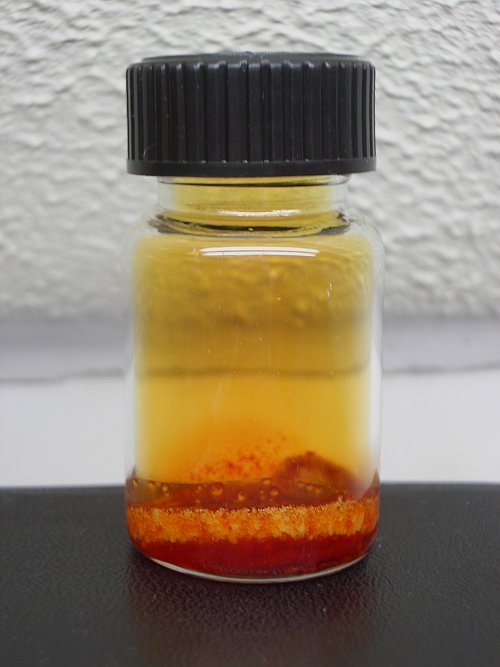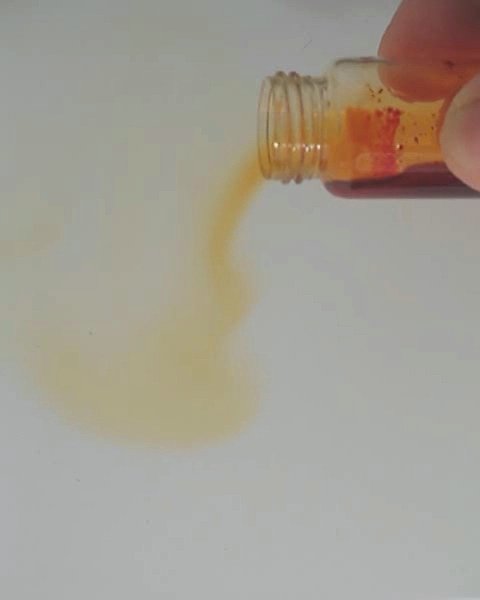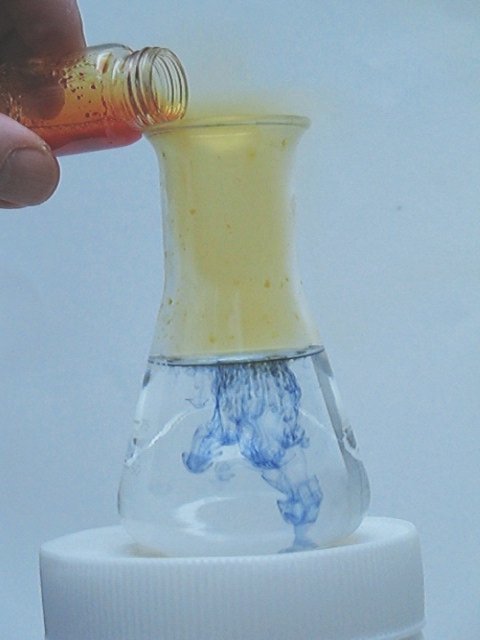


Chromyl chloride properties
In this experiment, some of the properties of the chemical compound chromyl chloride, CrO2Cl2 are shown. This compound is a remarkably interesting compound with peculiar properties.
Chromyl chloride can be made easily and isolation of this compound in small quantities as its vapor is very easy. It is really striking to see a metal as part of such a volatile compound. Also interesting is that this is a hexavalent chromium compound, which shows an interesting reaction with hydrogen peroxide. Combining the interesting properties of chromyl chloride with the interesting properties of hexavalent chromium in combination with hydrogen peroxide allows a beautiful experiment to be performed: an orange/brown gas is poured on a colorless liquid, resulting in beautiful blue streaks in the liquid.
![]()
![]() Required
chemicals:
Required
chemicals:
-
potassium dichromate
-
sodium chloride
-
hydrogen peroxide
-
sulphuric acid, concentrated (95% or better)
![]() Required
equipment:
Required
equipment:
-
small bottle or flask
-
erlenmeyer
-
test tube
![]() Safety:
Safety:
- Potassium dichromate is toxic. It contains hexavalent chromium and there is strong evidence that hexavalent chromium is a carcinogen. Be sure not to be exposed to this. Especially the route of inhalation is a risky route. Potassium dichromate is non-hygroscopic and a dry powder. Dust is formed easily.
-
 Chromyl chloride
is volatile, and accidental inhalation of some of the vapor must absolutely
be avoided. The vapor is irritating, but much more important is that this
also is a hexavalent chromium compound, and exposure by breathing some of
the vapor is exceptionally easy.
Chromyl chloride
is volatile, and accidental inhalation of some of the vapor must absolutely
be avoided. The vapor is irritating, but much more important is that this
also is a hexavalent chromium compound, and exposure by breathing some of
the vapor is exceptionally easy. - Concentrated sulphuric acid is very corrosive. Avoid contact with the skin. If there is accidental contact, then immediately wipe off the acid with a dry tissue and rinse with plenty of cold water.
![]() Disposal:
Disposal:
- Any remains of the acid mix with potassium dichromate and/or chromyl chloride in it must be diluted by immersing it at once in a beaker, full with water. Some of the solid may take quite some time before it has dissolved. When all is dissolved, neutralize the hexavalent chromium by adding sodium sulfite. The hexavalent chromium then is converted to trivalent chromium. This blue/green liquid can be flushed down the drain. The amount of trivalent chromium only is small (100 mg or so).
![]()
Formation of chromyl chloride
Take a spatula full of sodium chloride and a spatula full of potassium dichromate (appr. 250 mg of each) and put this in a small vial. Add 2 ml of concentrated sulphuric acid. This results in immediate bubbling, and formation of an orange/brown gas, and some oily drops of a deep red liquid. The pictures below show the situation before adding acid, and the situation, after adding the acid.


The following small video shows the formation of this compound: video of formation of chromyl chloride. Besides the chromyl chloride, also HCl is formed. This gas fumes, when in contact with air. The fuming (fog) also is visible in the video.
![]()
High density of chromyl chloride vapor
The vapor of chromyl chloride is very dense, compared to the density of air. In order to show this effect, one best can wait, until formation of bubbles (mainly HCl) stops and then the contents of the vial is slightly heated (to 70 C or something like that) with a hair dryer. In this way, a nice concentration of chromyl chloride is built up in the vial (the droplets of deep red liquid evaporate). This gas then can be poured out of the vial easily.

A video shows the pouring of the gas. It is quite spectacular to see this. Click the following link for the video: pouring of chromyl chloride from vial.
![]()
Reaction of vapor with very dilute solution of H2O2
This part of the experiment is most surprising. First, prepare 100 ml of a very dilute solution as follows:
- put approximately 100 ml of water in an erlenmeyer
- add 0.5 ml of concentrated sulphuric acid
- add 3 ml of 3% hydrogen peroxide
- stir with a clean rod, or swirl around such that all is well mixed
The resulting solution has appr. 0.1% of hydrogen peroxide and almost 1% of sulphuric acid.
On this solution, carefully pour some of the gaseous chromyl chloride, taking care that no liquid is dripped into the erlenmeyer. The effect is really stunning!

A video is made of this reaction. It really is nice to watch the gas go down and see the formation of the blue peroxo compound in the liquid. Click the following link for the video: formation of peroxo compound.
![]()
Discussion of the results
![]() When a dichromate, sulphuric acid and sodium chloride are
brought together, then two reactions occur at the same time. In one reaction,
gaseous HCl is formed, in the other reaction, chromyl chloride is formed. The
equations are given below:
When a dichromate, sulphuric acid and sodium chloride are
brought together, then two reactions occur at the same time. In one reaction,
gaseous HCl is formed, in the other reaction, chromyl chloride is formed. The
equations are given below:
K2Cr2O7 + 6H2SO4 + 4NaCl → 2CrO2Cl2 + 4NaHSO4 + 2KHSO4 + 3H2O
H2SO4 + NaCl → NaHSO4 + HCl
Both reactions occur at the same time. In practice, the reactions may even be more complicated, e.g. HCl, formed in the reaction may also react with K2Cr2O7 and form CrO2Cl2, the water formed being taken away by sulphuric acid.
![]() Chromyl chloride is hydrolysed by water. When it comes in
contact with water, then the following reactions occur:
Chromyl chloride is hydrolysed by water. When it comes in
contact with water, then the following reactions occur:
2CrO2Cl2 + 3H2O → Cr2O72- + 6H+ + 4Cl–
![]() The dichromate in turn reacts with the hydrogen peroxide in
acidic solution to the deep blue chromium peroxo compound CrO5. A
better formula for the deep blue compound is CrO(O2)2.
The dichromate in turn reacts with the hydrogen peroxide in
acidic solution to the deep blue chromium peroxo compound CrO5. A
better formula for the deep blue compound is CrO(O2)2.
Cr2O72- + 2H+ + 4H2O2 → 2CrO(O2)2 + 5H2O